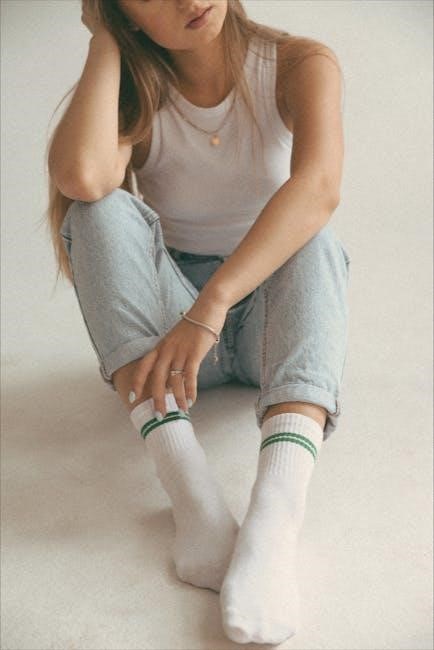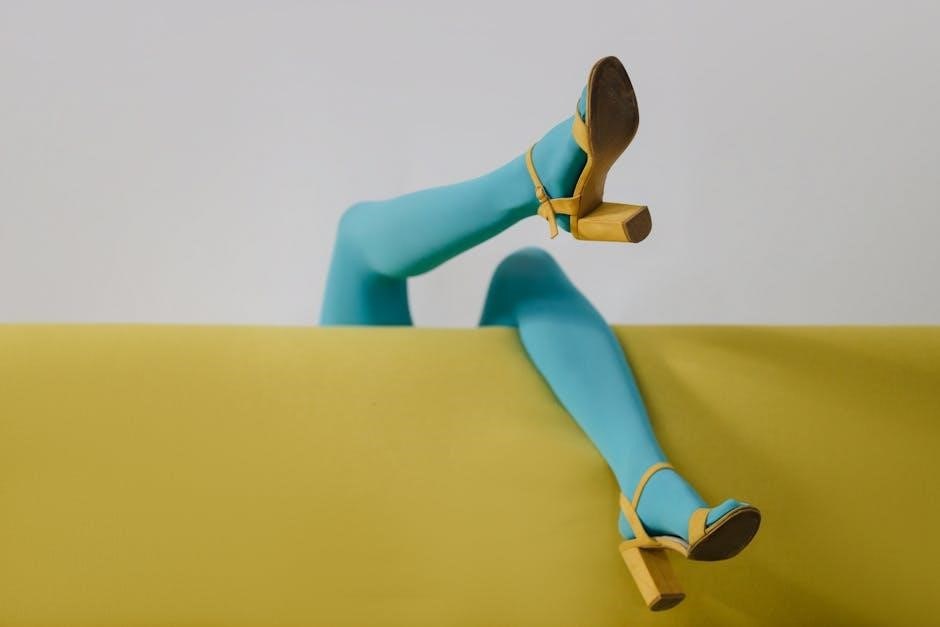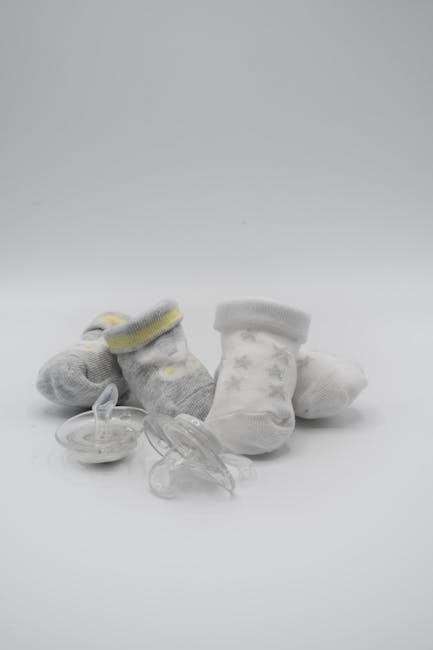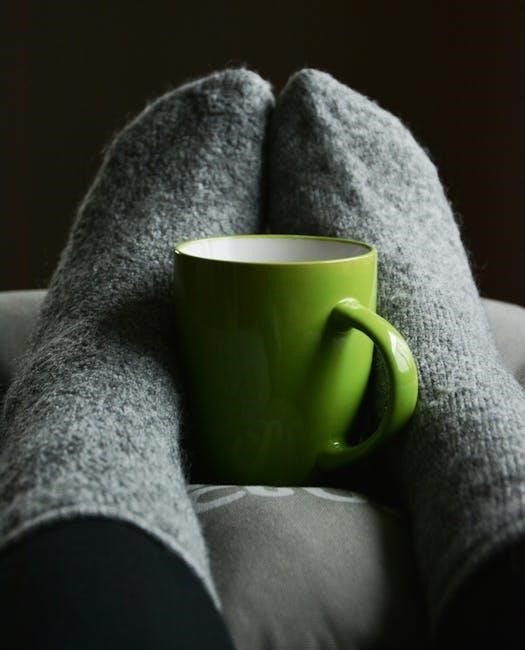Choosing the right sock size can significantly impact comfort and foot health.
This guide helps navigate sock sizing systems.
Understand US, UK, and EU standards for a perfect fit.
Discover how to measure your feet accurately for socks.
Importance of Correct Sock Size
Selecting the proper sock size is crucial for overall foot comfort and health. Socks that are too small can restrict circulation, leading to discomfort, cramping, and potential long-term issues. Conversely, socks that are too large may bunch up inside shoes, causing blisters and irritation due to friction. Ill-fitting socks can also compromise the effectiveness of moisture-wicking materials, leading to sweaty feet and an increased risk of fungal infections.
The right sock size ensures proper cushioning and support, which is especially important for athletic activities or prolonged periods of standing. A well-fitted sock can also improve the fit and feel of your shoes, enhancing overall comfort and performance. Moreover, correctly sized socks contribute to the longevity of both your socks and your shoes by preventing excessive wear and tear.
Ultimately, investing in socks that fit well is an investment in your foot health and comfort, promoting an active and pain-free lifestyle.
Brief History of Socks
The history of socks stretches back centuries, with evidence suggesting their existence as early as the Bronze Age. Early forms of socks were simple foot coverings made from animal skins or woven fabrics, primarily for protection and warmth. In ancient Egypt, knitted socks dating back to 300-500 AD have been discovered, showcasing intricate patterns and designs. The Romans also adopted socks, referring to them as “soccus,” a term derived from the Greek word “sykchos,” meaning a light shoe.
During the Middle Ages, socks evolved into longer stockings, often worn by both men and women. These stockings were typically hand-knitted and served as a status symbol, with elaborate designs indicating wealth and social standing. The invention of the knitting machine in the 16th century revolutionized sock production, making them more accessible and affordable. Today, socks are a ubiquitous part of our wardrobe, available in countless styles, materials, and sizes, reflecting their long and fascinating journey through history.

Understanding Sock Sizing Systems
Sock sizes vary by region.
US, UK, and EU systems differ.
Conversion charts help find the right fit.
Knowing your size ensures comfort.
Different brands may have slight variations.
US Sock Sizes
In the United States, sock sizes are typically based on the length of the foot in inches. This measurement differs from shoe sizes, which have their own calculation methods.
US sock sizes are generally offered in a few broad ranges, such as small, medium, and large.
These sizes correspond to specific foot lengths, allowing you to choose the best fit.
For example, a sock size 9-11 typically fits women’s shoe sizes 5-10.
Men’s sock sizes also follow this inch-based system, though the corresponding shoe sizes are different.
Specialized socks like compression socks may come in single US sock sizes.
If you’re unsure of your US sock size, measuring your foot length is the most accurate method.
Alternatively, conversion charts can help you determine your sock size from your shoe size.
Knowing your US sock size ensures a comfortable and proper fit for your feet.
UK Sock Sizes
Understanding UK sock sizes is crucial for those purchasing socks in the United Kingdom or from UK-based retailers. The UK sock sizing system often aligns closely with UK shoe sizes, making it relatively straightforward to find the correct fit.
Generally, sock sizes are expressed as a range that corresponds to shoe sizes. For instance, a sock might be labeled as fitting UK shoe sizes 4-7.
It’s worth noting that UK and Australian shoe sizes are the same, so the same sock sizes apply in both countries;
To determine your UK sock size, you can refer to conversion charts that correlate UK shoe sizes to foot length in inches or centimeters.
This ensures an accurate fit, especially when purchasing socks online.
Keep in mind that some brands may have slight variations in their sizing, so it’s always a good idea to check the specific size guide provided by the manufacturer.
By understanding UK sock sizes, you can confidently select socks that provide optimal comfort and support for your feet.
EU Sock Sizes
Understanding EU sock sizes is important for those buying socks in Europe or from European brands. The EU sizing system differs from the US and UK systems, so knowing the conversion is essential for a proper fit.
EU sock sizes are generally based on shoe sizes, with a range indicating the foot size the sock is designed to accommodate. For example, a sock might be labeled as fitting EU shoe sizes 39-42.
To find your EU sock size, you can consult a conversion chart that matches EU shoe sizes to foot length in centimeters. This is the most accurate way to determine your size, especially when shopping online.
Keep in mind that sizing can vary slightly between brands, so it’s always best to check the specific size guide provided by the manufacturer.
When in doubt, measuring your foot length and comparing it to the brand’s size chart is the most reliable method.
By understanding EU sock sizes, you can ensure that your socks fit comfortably and provide the support you need for various activities.

Sock Size Charts for Adults
Adult sock sizes differ for men and women.
Charts correlate shoe size to sock size.
Find your perfect fit for optimal comfort.
Refer to specific charts for accurate sizing.

Men’s Sock Size Chart
Finding the right sock size for men involves understanding the relationship between shoe size and corresponding sock dimensions. Men’s sock sizes are typically indicated by numbers (e.g., 10-13) or by general sizes (small, medium, large, extra large). These sizes correspond to a range of men’s shoe sizes. Most brands use the sizing 9-11 and 10-13, which refers to the actual length in inches of your foot, not your shoe size.
To determine your sock size, first identify your US shoe size. Then, consult a men’s sock size chart to find the appropriate sock size range. Remember that UK and Australian shoe sizes are the same. For example, a men’s shoe size 11 usually requires an extra-large sock. It is also important to note that some brands may use slightly different sizing conventions, so it is always a good idea to consult the brand’s specific size guide if available.
When in doubt, measuring your foot length in inches can provide the most accurate indication of your ideal sock size.
Women’s Sock Size Chart

Understanding women’s sock sizes is crucial for ensuring a comfortable and proper fit. Women’s sock sizes are generally indicated by a numerical range, such as 9-11, or by descriptive sizes like small, medium, and large. These sizes correlate to a specific range of women’s shoe sizes. Different brands may use varying size standards, so consulting a size chart is always recommended.
To find your correct sock size, first, determine your US women’s shoe size. Then, refer to a women’s sock size chart to identify the corresponding sock size range. For example, a women’s shoe size between 5 and 10 typically corresponds to a sock size of 9-11. If your shoe size falls on the higher end of a range, consider sizing up to the next sock size for a more comfortable fit. A US shoe size 5-7 typically fits 22-23.5 cm, while sizes 8-10 correspond to 24-25.5 cm.
If you are between sizes, consider the sock’s material and stretch. In some cases, men’s socks might be an option for larger shoe sizes, offering a wider variety of styles and patterns.

Sock Size Charts for Children
Finding the correct sock size for children involves considering age and shoe size.
Charts provide guidelines for accurate fitting.
Individual growth rates require occasional adjustments to ensure comfort.

Children’s Sock Sizes by Age
Determining children’s sock sizes by age offers a general guideline, but individual variations exist.
Typically, newborn socks fit infants aged 0-6 months.
Socks labeled for toddlers are designed for children aged 1-3 years.
Preschoolers aged 3-5 years usually require a slightly larger sock size.
School-aged children between 6-10 years often fit into youth sizes.
However, growth spurts can influence sock size needs.
Always check sizing charts from specific brands.
Consider measuring foot length for a more precise fit.
Some children may need a larger size due to wider feet.
Age-based sizing provides a starting point, not a definitive answer.
Flexible socks with some stretch can accommodate varying foot sizes.
Remember that comfort is key when choosing socks for children.
Avoid socks that are too tight, which can restrict circulation.
Socks that are too loose may bunch up and cause discomfort.
Regularly check sock fit to ensure proper support and warmth.
Children’s Sock Sizes by Shoe Size
Matching children’s sock sizes to shoe sizes offers a more accurate fit than age-based guidelines.
Typically, children’s shoe sizes range from infant sizes to youth sizes.
Sock manufacturers often provide size charts correlating shoe size to sock size.
For example, a child wearing a US shoe size 5-7 may require a small sock.
A child with a shoe size of 8-10 might need a medium sock.
Larger shoe sizes, such as 11-13, often correspond to a large sock size.
Consult the specific brand’s size chart for precise measurements.
Different regions may use different shoe sizing systems.
Convert shoe sizes if needed using online conversion tools.
Consider the sock’s material and stretch when selecting a size.
Some materials may shrink or stretch after washing.
Opt for socks that provide adequate coverage and support.
Ensure the sock’s heel aligns properly with the child’s heel.
Avoid socks that are too tight, restricting foot movement.
Socks that are too loose can cause blisters and discomfort.
Regularly assess the sock’s fit as the child’s foot grows.

Measuring Your Foot for Socks
Accurate foot measurement is crucial for optimal sock fit.
Measure foot length to determine the correct size.
Convert shoe size if direct measurement isn’t possible.
This ensures comfort and prevents blisters.
How to Measure Foot Length
To accurately determine your sock size, measuring your foot length is essential.
Begin by placing a piece of paper against a wall.
Position your heel firmly against the wall on the paper.
Ensure your foot is flat and not arched.
Using a pencil, mark the longest point of your foot on the paper.
This is usually the tip of your big toe, but can be your second toe for some.
Measure the distance from the edge of the paper (where your heel was) to the pencil mark.
This measurement is your foot length.
Repeat the process for the other foot, as foot sizes can vary slightly.
Use the larger of the two measurements to determine your sock size using a size chart.
Always measure your feet at the end of the day, when they are most swollen.
Wear the type of socks you would normally wear with shoes for a more accurate measurement.
Round up to the nearest inch for US sock sizes.
Converting Shoe Size to Sock Size
Converting your shoe size to sock size offers a convenient way to find the right fit.
Most sock brands provide size charts that correlate shoe sizes to sock sizes.
Consult these charts to determine your appropriate sock size based on your shoe size.
Keep in mind that shoe sizes can vary slightly between brands.
Therefore, it’s always best to refer to the specific sock brand’s size chart;
US sock sizes are often based on foot length in inches.
If you know your shoe size, you can use a conversion chart to estimate your foot length.
Then, use that length to find your sock size.
Remember that men’s and women’s shoe sizes differ, so use the appropriate chart.
For example, a women’s size 8 is roughly equivalent to a men’s size 6.
If you’re between sizes, it’s generally recommended to size up for socks.
This provides more room and prevents the socks from being too tight.
Consider the type of socks you’re buying.
Thick socks may require a larger size than thin socks.

Factors Affecting Sock Size Choice
Sock material and stretch play a key role in size selection.
Consider sock height preferences when choosing the right size.
These factors influence how socks fit and feel.
Sock Material and Stretch
The material composition significantly impacts a sock’s stretch and overall fit.
Different materials have varying degrees of elasticity.
Cotton socks tend to shrink after washing, influencing size choice.
Wool socks offer natural stretch and moisture-wicking properties.
Synthetic materials, such as nylon and spandex, enhance stretch and durability.
Consider the material’s properties when selecting a sock size.
Stretchy materials might allow for sizing down, while less elastic ones may need sizing up.
Pay attention to the blend of materials in the sock.
A blend of cotton and spandex offers a balance of comfort and stretch.
Different knitting patterns can also affect the stretch and fit.
Ribbed socks tend to be more elastic than flat-knit socks.
The thickness of the yarn also influences the sock’s stretch.
Thicker yarns may provide less stretch than thinner yarns.
Consider how the material will react to washing and drying.
Some materials are more prone to shrinking or stretching than others.
Sock Height Considerations
Sock height plays a crucial role in comfort and style.
Different sock heights are suitable for various activities and footwear.
Ankle socks are ideal for low-cut shoes and warmer weather.
Crew socks offer more coverage and are versatile for everyday wear.
Quarter socks provide minimal ankle coverage, offering a balance of support and breathability.
Knee-high socks are often worn for sports or to provide extra warmth.
Over-the-calf socks offer maximum coverage and are commonly used in athletic settings.
Consider the intended use of the socks when selecting the height.
Taller socks may provide better protection and support during exercise.
Shorter socks might be more comfortable for casual wear in warm climates.
The height of the sock can also affect the fit around the calf.
Tighter socks around the calf can restrict circulation.
Looser socks may slide down and bunch up.
Choose a height that complements your footwear and activity level.
Consider the aesthetic appeal of different sock heights with your outfit.
Experiment with different heights to find your preferred style and comfort level.

Tips for Choosing the Right Sock Size
Selecting the correct sock size ensures comfort and proper fit.
Consider sizing up or down based on foot measurements.
Consult brand-specific size guides for accurate information.
Prioritize comfort and functionality when choosing socks.
When to Size Up or Down
Determining when to adjust sock size involves several considerations. If your foot measurement falls between sizes, opting for the larger size is generally recommended to avoid constriction and discomfort. This is particularly important for individuals with wider feet or those who prefer a looser fit.
Conversely, if you find that socks consistently slip down or bunch up at the toes, sizing down might provide a more secure and comfortable fit. However, be cautious not to choose a size that is too small, as this can restrict circulation and lead to blisters or other foot problems.
Consider the sock’s material as well. Some materials, like cotton, may shrink after washing, so sizing up slightly might be beneficial. Conversely, synthetic materials often retain their shape and size, so sticking with your usual size is typically sufficient.
Remember to prioritize comfort and foot health when making sizing decisions. If you’re unsure, try on socks of different sizes to determine which feels best.
Checking Brand-Specific Size Guides
Navigating the world of sock sizes can be tricky, as sizing can vary significantly between brands. Always consult the brand’s specific size guide before making a purchase. What might be a “medium” in one brand could be a “small” or “large” in another.
Brand-specific size guides often provide detailed measurements, such as foot length or shoe size ranges, to help you find the perfect fit. These guides may also include information on material composition and stretch, which can influence sizing decisions.
Some brands offer unique sizing systems that differ from standard US, UK, or EU sizes. Paying attention to these nuances can prevent the frustration of receiving socks that don’t fit properly.
Furthermore, customer reviews can offer valuable insights into the accuracy of a brand’s size guide. Look for feedback from other buyers regarding sizing discrepancies or fit issues.
By taking the time to check brand-specific size guides, you can increase your chances of finding socks that provide optimal comfort, support, and durability.
